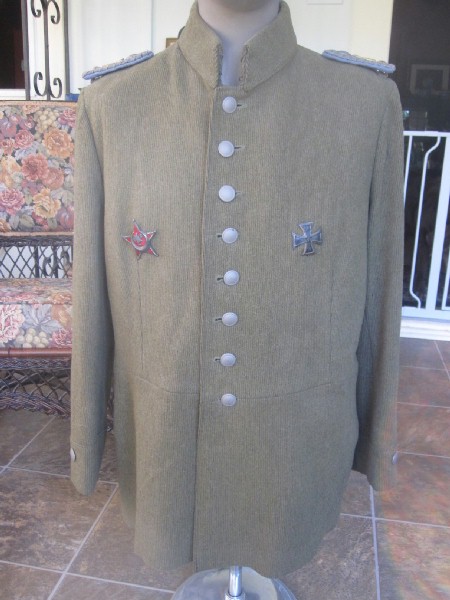| |
|
|
| |
Tunic of a German Officer who served on the
Bagdad Railway in the First World War
Photos © A Private US Collector
The photographs on this page show a privately tailored tunic made for
Oberleutnant Kloevekorn while serving on the Berlin-Bagdad Railway. The
tunic is similar in cut to those worn by Train officers of the Prussian
army serving in Europe except that it is made of brown corduroy. Further
below are shown Oberleutnant Kloevekorn's medals certificates.
| |
Wilhelm Kloevekorn was made
Leutnant der Reserve in the 18th Prussian Samland Pioneer Battalion ("Samländisches
Pionier-Bataillon
Nr. 18") on 18th October 1902. This unit was based at Königsberg
and suggests he was from East Prussia. In civilian life he was a railway
construction and operating inspector and in 1911 he worked on the
Tsingtao Railway. In the 1914
Prussian Army List he is noted as a Leutnant der Landwehr Pioniere in
Landwehrbezirk I Bremen. During the First World
War he was promoted to Oberleutnant der Landwehr on 8th March 1916 and served as commander of Bauabteilung IV on the Bagdad
Railway. Although not fully
completed in 1914, the Berlin-Bagdad Railway was an essential link between the
German and Ottoman Empires, especially after Bulgaria joined the war on
the side of the Central Powers and Rumania surrender, leaving a clear
route between the two allies. After the war Kloevekorn returned to
working on German railways and continued to do so in the Second World War. |
|
|
|
| |
|
|
| |
|
|
The tunic is made from heavy duty khaki corduroy in the same cut
as that of a Prussian army officers 1910 field grey uniform, note
the scalloped rear skirts and the Swedish style cuffs of a train
officer. It has an officer's quality silk lining and standing
collar. The shoulder straps are those of Prussian Train
Oberleutnant (as displayed by the Prussian black and white threads,
the stylised E for "Eisenbahn" or Railway and the single rank
pip of an "Oberleutnant" or First Lieutenant).
The main differences between this
tunic and one used by a Prussian Train officer on other fronts (apart from the use of
corduroy instead of field grey cloth), are the
lack of piping and the use of plain buttons. Prussian army buttons
would usually have had the royal crown on them but these are plain.
They are German made (with "EXTRA
FEIN" on the rear) but are
similar to those used from 1876 by the Ottoman army, which were also
German made. This opens the possibility that this tunic was made by
a Turkish rather than a German tailor.
A Prussian Iron Cross, first class is
worn on the left breast and an Ottoman War Medal (sometimes known as
an Iron Crescent or Gallipoli Star) on the right. As we will see
from Kloevekorn's medal certificates below his Iron Cross, first
class was was not worn during the First World War as it was only
awarded at the very end of the war.
| |
Wilhelm Kloevekorn's Medal Certificates |
|
| |
|
|
| |
 |
|
| |
Certificate for the Prussian Iron
Cross, second class awarded on 30th August 1917 and signed by
General Liman von Saunders. |
|
| |
|
|
| |
 |
|
| |
Certificate for the Turkish War Medal
awarded in 1916 in the name of Enver Pascha. See
Axis History Forum for a translation of this document. |
|
| |
|
|
| |
 |
|
| |
Certificate for the Prussian Iron
Cross, first class awarded on 30th October 1918 and signed by
General Liman von Saunders. This was the same day that the
Ottoman Empire signed the Armistice of Moutros surrendering
to the Allied Entente Powers. |
|
| |
|
|
| |
 |
|
| |
Certificate for the Ottoman Liakat Medal in
silver with swords, awarded on the 31st October 1918, signed
by General Liman von Saunders. This was the day after the
Ottoman Empire surrendered. |
|
| |
|
|
| |
 |
|
| |
Certificate for the
German Gold Loyal Service Award
for 40 years service awarded on 23rd July 1938 and signed by
Adolf Hitler. |
|
| |
|
|
| |
 |
|
| |
Certificate for the
German War Service Cross, second class awarded on 1st
September 1941 and signed by
Adolf Hitler. |
|
| |
|
|
| |
|
|
| |
These photographs were
originally shown on the
Pickelhaubes Fourm.
Thanks to the Private US Collector for sharing these
photographs with us and to Glenn Jewison, Christopher
Flaherty, Tosun Saral and
Mahmut Hakkı Sevgener for the additional research.
Please contact me
here if you have more information on this topic.
Back to Main Menu for German
Colonial Uniforms
|
|
| |
|
|
|














